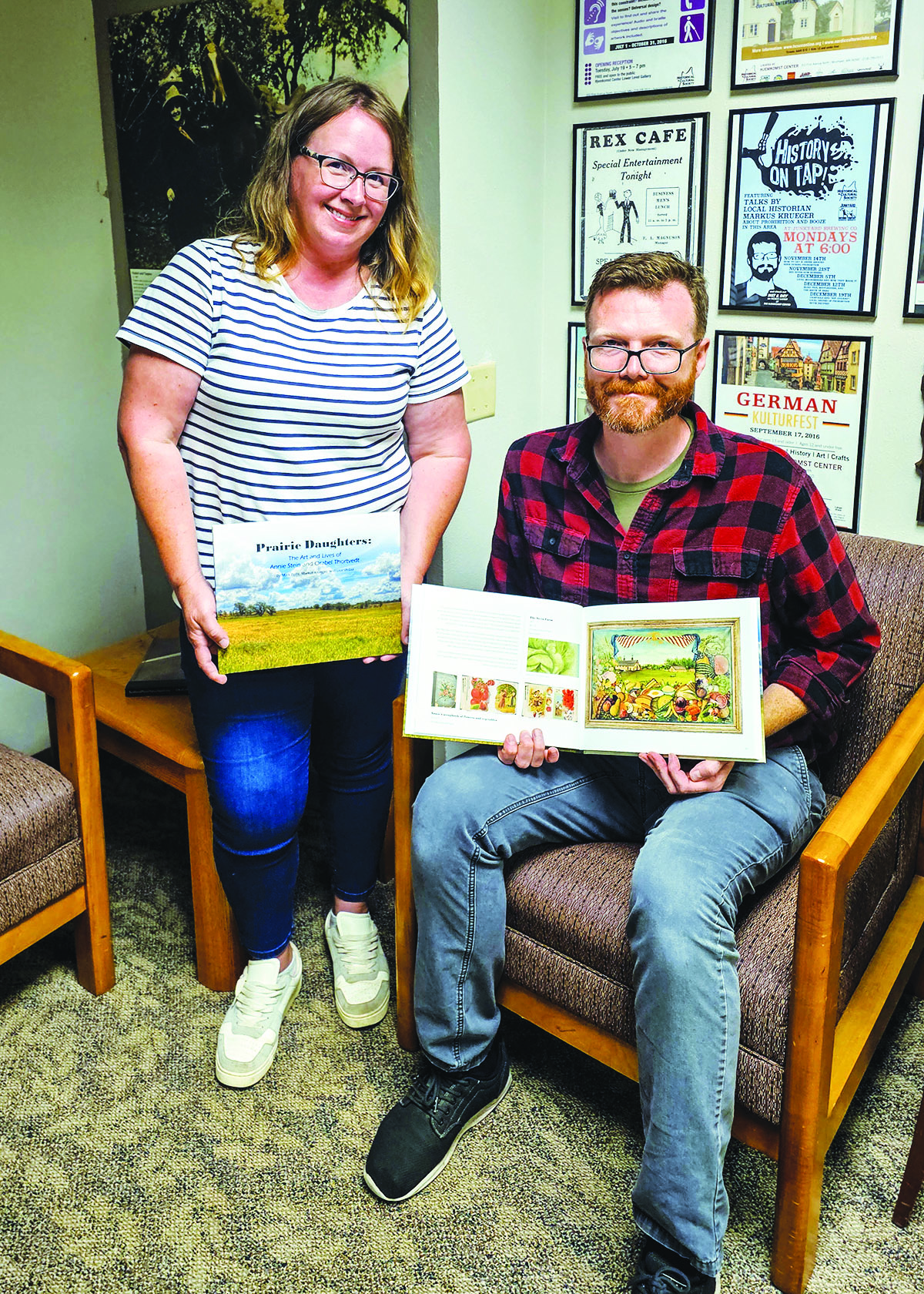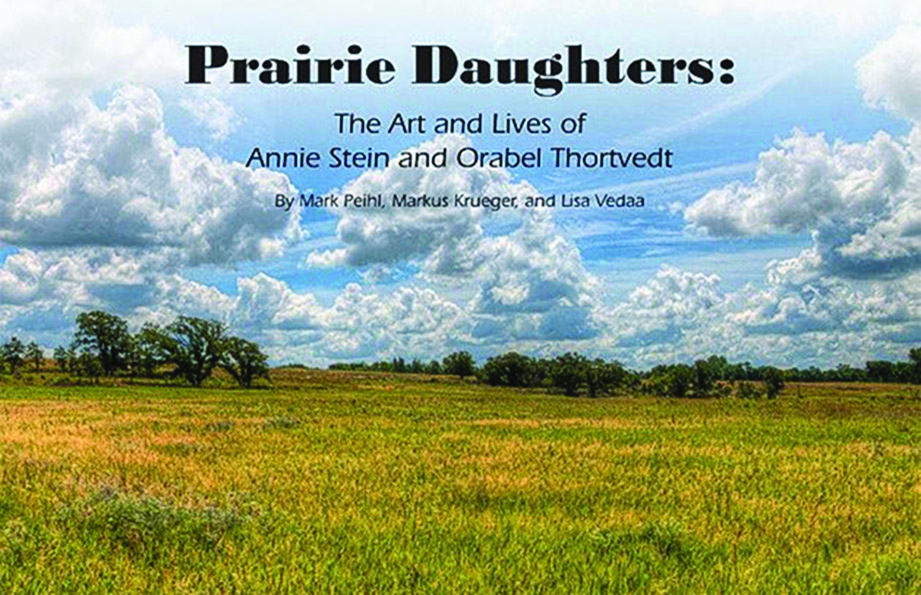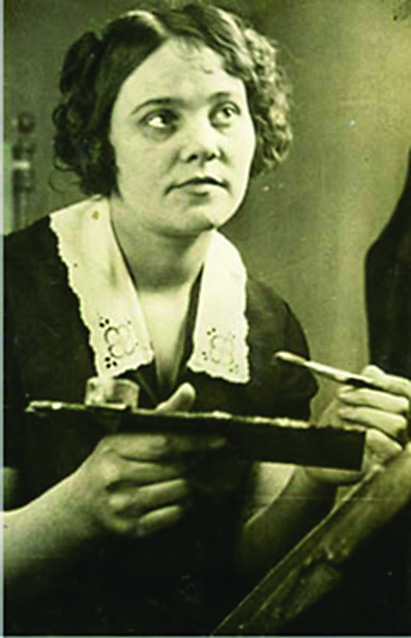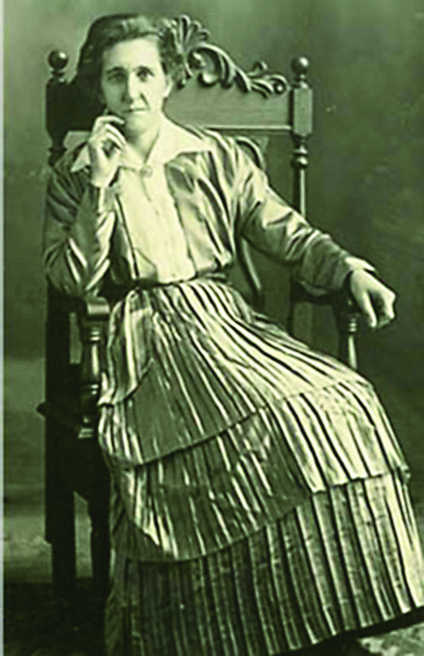
Historical Society collections manager Lisa Vedaa and program director Markus Krueger show off the HCSCC’s new book on Moorhead’s two earliest artists, Annie Stein and Orabel Thortvedt.( Photo/Nancy Hanson.)

“Prairie Daughters,” the new book published by the Historical and Cultural Society of Clay County, is available at the Hjemkomst Center gift store.
Book celebrates Moorhead’s pioneer artists
Nancy Edmonds Hanson
Long before galleries emerged to feature the work of Red River Valley artists, two rural women took their places as another kind of Clay County pioneer: Not farmers like the immigrant families who raised them, but – breaking unlikely ground – as two of the area’s earliest creative artists.
Their paintings brightened the walls of family members’ and neighbors’ homes around Georgetown, where Annie Stein lived out her life on the family farm, and Glyndon. where Orabel Thortvedt grew up on a Buffalo River farmstead. Far from the sophisticated galleries of New York City and Paris, neither achieved fame or fortune with their creations. But now their lifetimes immersed in creativity, reflecting both their talent and their times, are reaching new generations, thanks to a handsome book published this summer by the Historical and Cultural Society of Clay County.
Three of the HCSCC’s historians have spent more than a decade uncovering the two early artists’ paintings and their stories. Mark Peihl, Markus Krueger and Lisa Vedaa began gathering Annie’s and Orabel’s artworks and delving into their stories more than a decade ago.
Their original research resulted in a ground-breaking exhibition at the Hjemkomst Center in 2013. “But an exhibition ends. We thought their stories should go on,” says Krueger, the HCSCC’s program director. “They were not just really good artists. Their work tells the story of their times, and we wanted to preserve the story of what it was like to be a woman artist.”
A decade after the exhibit’s close, the historical group finally secured funds to publish the pioneer artists’ art, along with their stories. The grant came from the Minnesota Historical Society funded by the Legacy Fund (Minnesota Arts and Cultural Heritage Fund).
Prairie Daughters: The Art and Lives of Annie Stein and Orabel Thortvedt captures much of the body of work created by each woman over lives lived out on the farms where they were born. Much of the challenge of assembling the book lay in tracking down their paintings and other artistic endeavors – photographs, hand-painted china, needlework, writings and even songs.
Krueger credits amateur historian and collector Kelly Wambach with planting the seed for the project, both the exhibit and the new book. “After Annie died a century ago, her eight brothers and sisters cherished her paintings and kept them together,” he explains. But when her last surviving sister moved into a nursing home in 1976, they went up for auction, along with the rest of her household.
Kelly spotted the paintings at the auction. “He recognized their importance and bought as many as he could, and he remembered who else went home with whatever else there was,” the historian reports. Wambach loaned his collection for the museum exhibit and suggested where to find others.
Many of Orabel’s paintings were shared by her family, taken down from their own walls. Others were gathered from the woman’s painting studio, still maintained on the farm 30 years after her death.
While their stories were similar, the two artists – born a generation apart – likely knew little of each other. Annie, the elder, had no formal art training. She taught herself to paint, using family photographs or pictures cut out of magazines as subjects. She also taught herself photography.
She was proud of her work. When she finished a painting, she often put on her finest clothing and posed for a photo beside it. But modesty also prevailed in the message written on the back of many of her paintings: “Please do not criticize this work too much, for God along was my ‘master.’”
Among her subjects were the old Hudson’s Bay crossing at Georgetown, the Georgetown Hotel, the family farm and home, scenes from the Spanish American War, the Red River floods of 1893 and 1897, and herself and sister Louise. She wrote a history of Georgetown told in her father’s voice, and also wrote verses that she paid to have set to music. Those songs, composed during the World War I era, included one about herself, “Annie. the Rannie,” which comes as close to autobiography as anything she wrote. (Sadly, it failed to reveal her meaning of “Rannie.”)
Orabel came from a family of writers who documented much about their lives. Among her accomplishments was the illustrated story of her family and neighbors’ journeys from Norway to Clay County. It was published in 2020, nearly 40 years after her death, as Red River Girl: From Telemark to the Buffalo, a joint project of HCSCC and the Ves-Telemark Museum in Norway.
Unlike Annie, Orabel had formal art training. She attended the Minneapolis Art Institute and University of Minnesota, then lived there for a time. A lifelong animal lover, she made her mark with animal portraiture, primarily wealthy families’ prized horses and dogs. She returned to the farm after her parents’ death and spent the rest of her life there. Her paintings often featured that farm and its surroundings. She captured the story of the region’s settlers, too, in a series of delicate, detailed pen-and-ink illustrations.
A sculptor as well, she carved life-size figures from the clay of the Red River Valley – sometimes carving directly into the clay banks of the Buffalo River. Though washed away by rain, snow and floods, she photographed them for posterity. She also painted birds and other critters on white china, a popular collectible of the day, and produced her own line of watercolor greeting cards. She exhibited one of her later paintings in the first Midwest Invitational exhibit organized by the Rourke Art Gallery shortly before her death.
Neither Annie nor Orabel ever married. “Instead of raising a family, both of them spent their lives pursuing most of the intellectual and artistic pursuits that were available for women in their day,” Vedaa observes. “There was no fine art scene here in those days.” She adds, “There may have been other women working here, too, whom we don’t know about yet. If people know of them, we’d love to hear it.”
Markus adds, “What was it like to start that scene here on the northern frontier? Their stories are important. We’re hoping this book will get people interested in Annie and Orabel, not only as historical figures but as artists.”
Prairie Daughters is available at the Hjemkomst Center Gift Shop. The $35 hard-cover volume can also be ordered directly from the historical society at www.hcscconline.org/store. A formal book launch party is planned Tuesday, Sept. 10, at 6:30 p.m.




